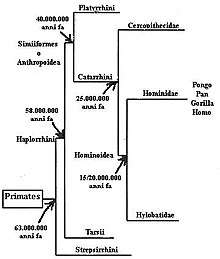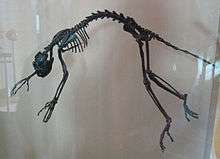Evolution of primates
The evolutionary history of the primates can be traced back 65 million years.[1] One of the oldest known primate-like mammal species, the Plesiadapis, came from North America;[2] another, Archicebus, came from China.[3] Other similar basal primates were widespread in Eurasia and Africa during the tropical conditions of the Paleocene and Eocene. Purgatorius is the genus of the four extinct species believed to be the earliest example of a primate or a proto-primate, a primatomorph precursor to the Plesiadapiformes, dating to as old as 66 million years ago.

David Begun has concluded that early primates flourished in Eurasia and that a lineage leading to the African apes and humans, including Dryopithecus, migrated south from Europe or Western Asia into Africa.[4] The early European fauna is exemplified by Darwinius, dated to 47 million years, early Eocene.[5] The surviving tropical population of primates, which is seen most completely in the upper Eocene and lowermost Oligocene fossil beds of the Faiyum depression southwest of Cairo, gave rise to all living species—lemurs of Madagascar, lorises of Southeast Asia, galagos or "bush babies" of Africa, and the anthropoids: platyrrhine or New World monkeys, catarrhines or Old World monkeys, and the great apes, which share common ancestors with Homo sapiens.
Origins
The origins and early evolution of primates is shrouded in mystery due to lack of fossil evidence. They are believed to have split from plesiadapiforms in Eurasia around the early Eocene or earlier. The first true primates so far found in the fossil record are fragmentary and already demonstrate the major split between strepsirrhines and haplorines.
Evolution of strepsirrhines
The earliest strepsirrhines were known as adapiforms, a diverse group that ranged throughout Eurasia and North America. An early branch of this clade gave rise to lemuriform primates, which includes lemurs and their kin.
Evolution of lemurs
Lemurs, in the suborder Strepsirrhini, had been isolated on the island of Madagascar between 42 and 50 mya, allowing for their independent evolution.
Evolution of haplorrhines
The earliest haplorrhine primates from the fossil record are the omomyids, which resembled modern day tarsiers. Like the strepsirrhine adapiforms, omomyids were diverse and ranged throughout Eurasia and North America. The phylogeny of omomyids, tarsiers, and simians is currently unknown.
For many years, it was assumed that primates had first evolved in Africa, and this assumption and the excavations that resulted from it yielded many early simian fossils that chronicled their evolution. Due to the lack of fossils linking simians to the earliest haplorrhines, a more recently discovered stem group called eosimiids found in Asia are thought to have dispersed to Africa and evolved into simians. Eosimiids were very small and similar to tarsiers, though their dentition more closely resembles that of simians.
Evolution of New World monkeys
Following the emergence of basal simians in Africa, the group split during the Eocene when New World monkeys dispersed to South America, presumably by rafting on mats of vegetation across the much narrower Atlantic Ocean.
Evolution of Old World simians
The earliest known catarrhine is Kamoyapithecus from uppermost Oligocene at Eragaleit in the northern Kenya Rift Valley, dated to 24 million years ago.[6] Its ancestry is thought to be species related to Aegyptopithecus, Propliopithecus, and Parapithecus from the Faiyum depression, at around 35 million years ago.[7] In 2010, Saadanius was described as a close relative of the last common ancestor of the crown catarrhines, and tentatively dated to 29–28 million years ago, helping to fill an 11-million-year gap in the fossil record.[8] Notable species also include Nsungwepithecus gunnelli and Rukwapithecus fleaglei, dubiously taxonomized catarrhines of the Oligocene.[9]
In the early Miocene, about 22 million years ago, the many kinds of arboreally adapted primitive catarrhines from East Africa suggest a long history of prior diversification. Fossils at 20 million years ago include fragments attributed to Victoriapithecus, the earliest Old World monkey. Among the genera thought to be in the ape lineage leading up to 13 million years ago are Proconsul, Rangwapithecus, Dendropithecus, Limnopithecus, Nacholapithecus, Equatorius, Nyanzapithecus, Afropithecus, Heliopithecus, and Kenyapithecus, all from East Africa.
The presence of other generalized non-cercopithecids of middle Miocene age from sites far distant—Otavipithecus from cave deposits in Namibia, and Pierolapithecus and Dryopithecus from France, Spain and Austria—is evidence of a wide diversity of forms across Africa and the Mediterranean basin during the relatively warm and equable climatic regimes of the early and middle Miocene. The youngest of the Miocene hominoids, Oreopithecus, is from coal beds in Italy that have been dated to 9 million years ago.
Molecular evidence indicates that the lineage of gibbons (family Hylobatidae) diverged from Great Apes some 18–12 million years ago, and that of orangutans (subfamily Ponginae) diverged from the other Great Apes at about 12 million years; there are no fossils that clearly document the ancestry of gibbons, which may have originated in a so-far-unknown South East Asian hominoid population, but fossil proto-orangutans may be represented by Sivapithecus from India and Griphopithecus from Turkey, dated to around 10 million years ago.[10]
Evolution of color vision
Human evolution
Human evolution is the evolutionary process that led to the emergence of anatomically modern humans, beginning with the evolutionary history of primates – in particular genus Homo – and leading to the emergence of Homo sapiens as a distinct species of the hominid family, the great apes. This process involved the gradual development of traits such as human bipedalism and language.[11]
The study of human evolution involves many scientific disciplines, including physical anthropology, primatology, archaeology, paleontology, neurobiology, ethology, linguistics, evolutionary psychology, embryology and genetics.[12] Genetic studies show that primates diverged from other mammals about 85 million years ago, in the Late Cretaceous period, and the earliest fossils appear in the Paleocene, around 55 million years ago.[13]
Within the superfamily Hominoidea (apes), the family Hominidae diverged from the family Hylobatidae (gibbons) some 15–20 million years ago; African great apes (subfamily Homininae) diverged from orangutans (Ponginae) about 14 million years ago; the tribe Hominini (humans, Australopithecines and other extinct biped genera, and chimpanzee) parted from the tribe Gorillini (gorillas) between 9 million years ago and 8 million years ago; and, in turn, the subtribes Hominina (humans and biped ancestors) and Panina (chimpanzees) separated about 7.5 million years ago to 5.6 million years ago.[14]
Evolution of the pelvis
In primates, the pelvis consists of four parts—the left and the right hip bones which meet in the mid-line ventrally and are fixed to the sacrum dorsally and the coccyx. Each hip bone consists of three components, the ilium, the ischium, and the pubis, and at the time of sexual maturity these bones become fused together, though there is never any movement between them. In humans, the ventral joint of the pubic bones is closed.
The most striking feature of evolution of the pelvis in primates is the widening and the shortening of the blade called the ilium. Because of the stresses involved in bipedal locomotion, the muscles of the thigh move the thigh forward and backward, providing the power for bi-pedal and quadrupedal locomotion.[15]
References
- Maxwell 1984, p. 296
- Rui Zhang; Yin-Qiu Wang; Bing Su (July 2008). "Molecular Evolution of a Primate-Specific microRNA Family". Molecular Biology and Evolution. Oxford, UK: Oxford University Press on behalf of the Society for Molecular Biology and Evolution. 25 (7): 1493–1502. doi:10.1093/molbev/msn094. ISSN 0737-4038. PMID 18417486. Pdf
- Willoughby, Pamela R. (2005). "Palaeoanthropology and the Evolutionary Place of Humans in Nature". International Journal of Comparative Psychology. International Society for Comparative Psychology. 18 (1): 60–91. ISSN 0889-3667. Retrieved 2015-04-27.
- Martin 2001, pp. 12032–12038
- Tavaré, Simon; Marshall, Charles R.; Will, Oliver; et al. (April 18, 2002). "Using the fossil record to estimate the age of the last common ancestor of extant primates". Nature. London: Nature Publishing Group. 416 (6882): 726–729. Bibcode:2002Natur.416..726T. doi:10.1038/416726a. ISSN 0028-0836. PMID 11961552.
- Rose, Kenneth D. (1994). "The earliest primates". Evolutionary Anthropology: Issues, News, and Reviews. Hoboken, NJ: John Wiley & Sons. 3 (5): 159–173. doi:10.1002/evan.1360030505. ISSN 1060-1538.
- Fleagle, John; Gilbert, Chris (2011). Rowe, Noel; Myers, Marc (eds.). "Primate Evolution". All The World's Primates. Charlestown, RI: Primate Conservation, Inc. Retrieved 2015-04-27.
- Roach, John (March 3, 2008). "Oldest Primate Fossil in North America Discovered". National Geographic News. Washington, D.C.: National Geographic Society. Retrieved 2015-04-27.
- McMains, Vanessa (December 5, 2011). "Found in Wyoming: New fossils of oldest American primate". The Gazette. Baltimore, MD: Johns Hopkins University. Retrieved 2015-04-27.
- Caldwell, Sara B. (May 19, 2009). "Missing link found, early primate fossil 47 million years old". Digital Journal. Toronto, Canada: digitaljournal.com. Retrieved 2015-04-27.
- Watts, Alex (May 20, 2009). "Scientists Unveil Missing Link In Evolution". Sky News Online. London: BSkyB. Archived from the original on 2011-07-28. Retrieved 2015-04-27.
- Wilford, J. N. (June 5, 2013). "Palm-size fossil resets primates' clock, scientists say". The New York Times. Retrieved June 5, 2013.
- Kordos, László; Begun, David R. (January 2001). "Primates from Rudabánya: allocation of specimens to individuals, sex and age categories". Journal of Human Evolution. Amsterdam, the Netherlands: Elsevier. 40 (1): 17–39. doi:10.1006/jhev.2000.0437. ISSN 0047-2484. PMID 11139358.
- Franzen, J. L.; Gingerich, P. D.; Habersetzer, J.; Hurum, J. H.; Von Koenigswald, W.; Smith, B. H. (2009). J., Hawks (ed.). "Complete primate skeleton from the Middle Eocene of Messel in Germany: morphology and paleobiology". PLoS ONE. 4 (5): e5723. Bibcode:2009PLoSO...4.5723F. doi:10.1371/journal.pone.0005723. PMC 2683573. PMID 19492084.CS1 maint: ref=harv (link)
- Cameron 2004, p. 76
- Wallace 2004, p. 240
- Zalmout, Iyad S.; Sanders, William J.; MacLatchy, Laura M.; et al. (15 July 2010). "New Oligocene primate from Saudi Arabia and the divergence of apes and Old World monkeys". Nature. London: Nature Publishing Group. 466 (7304): 360–364. Bibcode:2010Natur.466..360Z. doi:10.1038/nature09094. ISSN 0028-0836. PMID 20631798.
- Palmer, Chris (2013-05-16). "Fossils Indicate Common Ancestor for Old World Monkeys and Apes". Scientific American. Retrieved 2017-09-13.
- Srivastava 2009, p. 87
- Brian K. Hall; Benedikt Hallgrímsson (2011). Strickberger's Evolution. Jones & Bartlett Publishers. p. 488. ISBN 978-1-4496-6390-2.
- Heng, Henry H. Q. (May 2009). "The genome-centric concept: resynthesis of evolutionary theory". BioEssays. Hoboken, NJ: John Wiley & Sons. 31 (5): 512–525. doi:10.1002/bies.200800182. ISSN 0265-9247. PMID 19334004.
- Tyson, Peter (July 1, 2008). "Meet Your Ancestors". NOVA scienceNOW. PBS; WGBH Educational Foundation. Retrieved 2015-04-18.
- Dawkins 2004
- "Find Time of Divergence: Hominidae versus Hylobatidae". TimeTree. Retrieved 2015-04-18.
- Campbell 1998, p. 170
Bibliography
- Cameron, David W. (2004). Hominid Adaptations and Extinctions. Sydney: UNSW Press. ISBN 978-0-86840-716-6. LCCN 2004353026. OCLC 57077633.CS1 maint: ref=harv (link)
- Campbell, Bernard (1998). Human Evolution: An Introduction to Man's Adaptations (4th ed.). New York: Aldine de Gruyter. ISBN 978-0-202-02042-6. LCCN 98008760. OCLC 39323020.CS1 maint: ref=harv (link)
- Srivastava, R. P. (2009). Morphology Of The Primates And Human Evolution. New Delhi: PHI Learning Pvt. Ltd. ISBN 978-81-203-3656-8. OCLC 423293609.CS1 maint: ref=harv (link)
- Wallace, David Rains (2004). Beasts of Eden: Walking Whales, Dawn Horses, and Other Enigmas of Mammal Evolution. Berkeley, CA: University of California Press. p. 240. ISBN 978-0-520-23731-5. LCCN 2003022857. OCLC 56733801.CS1 maint: ref=harv (link)
Further reading
- John Buettner-Janusch (2 December 2012). Evolutionary and Genetic Biology of Primates. Elsevier Science. ISBN 978-0-323-15510-6.
- John G. Fleagle (8 March 2013). Primate Adaptation and Evolution. Academic Press. ISBN 978-0-12-378633-3.
- Van Schaik, Carel P., and Peter M. Kappeler. "The evolution of social monogamy in primates". Monogamy: mating strategies and partnerships in birds, humans and other mammals. Cambridge University Press, Cambridge (2003): 59–80.
External links
- Human evolution at the Encyclopædia Britannica
- The First Primates at anthro.palomar.edu
